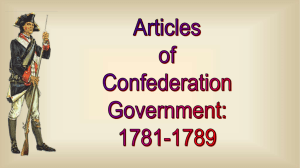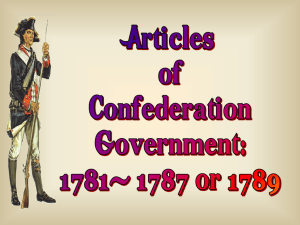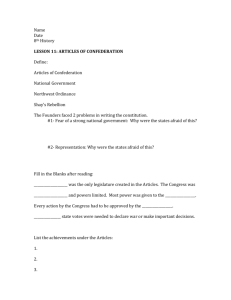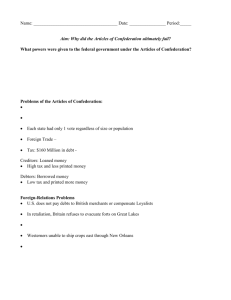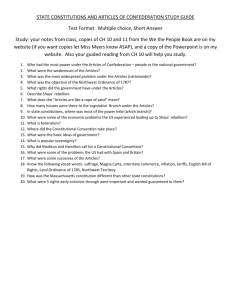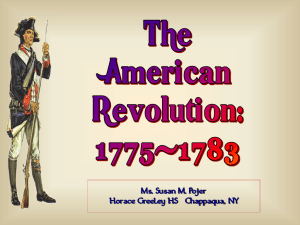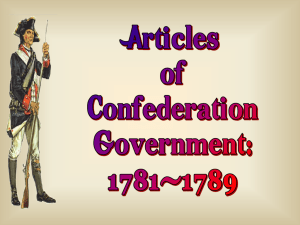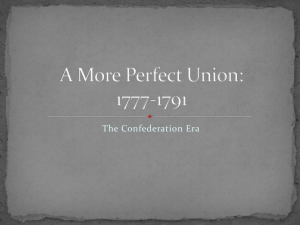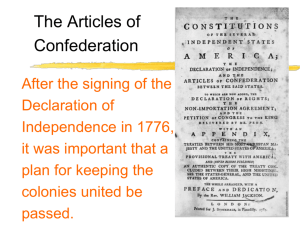Articles of Confederation
advertisement
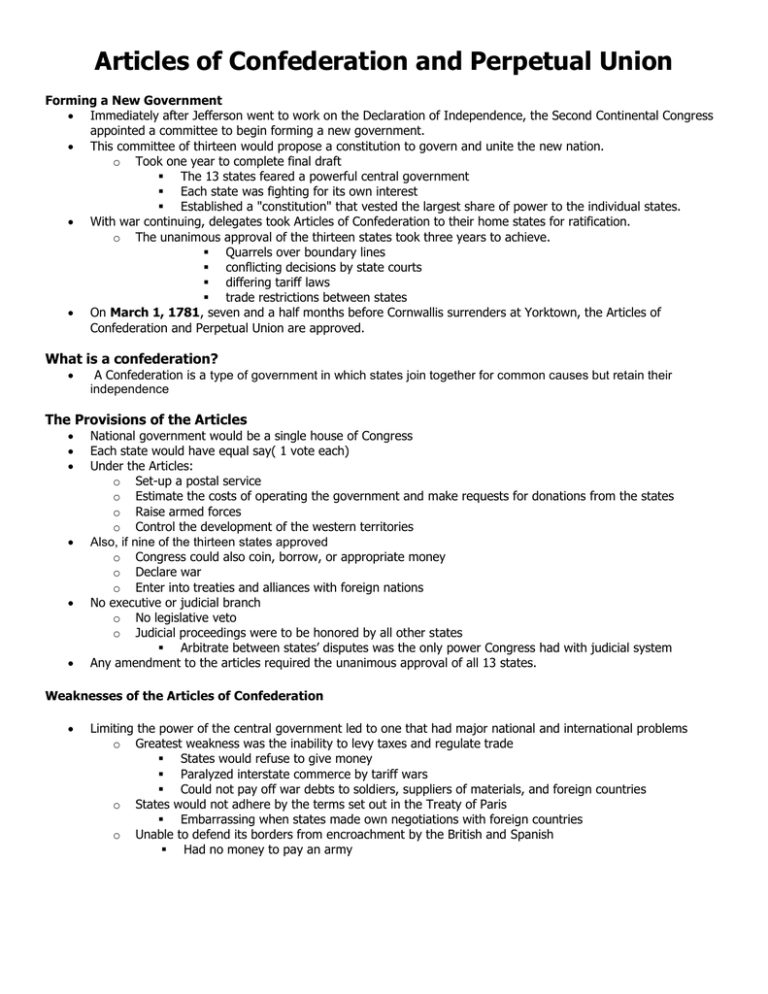
Articles of Confederation and Perpetual Union Forming a New Government Immediately after Jefferson went to work on the Declaration of Independence, the Second Continental Congress appointed a committee to begin forming a new government. This committee of thirteen would propose a constitution to govern and unite the new nation. o Took one year to complete final draft The 13 states feared a powerful central government Each state was fighting for its own interest Established a "constitution" that vested the largest share of power to the individual states. With war continuing, delegates took Articles of Confederation to their home states for ratification. o The unanimous approval of the thirteen states took three years to achieve. Quarrels over boundary lines conflicting decisions by state courts differing tariff laws trade restrictions between states On March 1, 1781, seven and a half months before Cornwallis surrenders at Yorktown, the Articles of Confederation and Perpetual Union are approved. What is a confederation? A Confederation is a type of government in which states join together for common causes but retain their independence The Provisions of the Articles National government would be a single house of Congress Each state would have equal say( 1 vote each) Under the Articles: o Set-up a postal service o Estimate the costs of operating the government and make requests for donations from the states o Raise armed forces o Control the development of the western territories Also, if nine of the thirteen states approved o Congress could also coin, borrow, or appropriate money o Declare war o Enter into treaties and alliances with foreign nations No executive or judicial branch o No legislative veto o Judicial proceedings were to be honored by all other states Arbitrate between states’ disputes was the only power Congress had with judicial system Any amendment to the articles required the unanimous approval of all 13 states. Weaknesses of the Articles of Confederation Limiting the power of the central government led to one that had major national and international problems o Greatest weakness was the inability to levy taxes and regulate trade States would refuse to give money Paralyzed interstate commerce by tariff wars Could not pay off war debts to soldiers, suppliers of materials, and foreign countries o States would not adhere by the terms set out in the Treaty of Paris Embarrassing when states made own negotiations with foreign countries o Unable to defend its borders from encroachment by the British and Spanish Had no money to pay an army Land Ordinance of 1785 (From http://www.u-s-history.com/pages/h1150.html) Thomas Jefferson was acutely aware of the great potential benefits offered by lands in the West. A growing population in the original states, now largely free from British interference, was beginning to push into these areas. Jefferson had earlier offered a systematic means to prepare new areas for statehood in his Ordinance of 1784. In the following year, he directed his attention to designing a system for surveying the lands that might avoid the pitfalls of earlier methods of determining boundaries. Many landowners in the original states had become embroiled in ownership disputes because their property lines were defined in terms of rocks, streams and trees — any of which could disappear or be moved. Another nagging feature of the old system was that frugal purchasers would buy only the best pieces of land by carving out irregular plots that avoided undesirable wasteland. Early land ownership maps appeared to be jigsaw puzzles. Jefferson’s proposal was much more orderly. He advocated the creation of a rectangular or rectilinear system of land survey. The basic unit of ownership was to be the township — a six-mile square or 36 square miles. (Jefferson had actually favored townships of 10-mile squares, but Congress believed those plots would be too large and difficult to sell.) Each township was to be divided into 36 sections, each a one-mile square or 640 acres. A north-south line of townships was to be known as a range. Borrowing from a New England practice, the Ordinance also provided that Section 16 in each township was to be reserved for the benefit of public education. All other sections were to be made available to the public at auction. The Ordinance provided that sections be offered to the public at the minimum bidding price of one dollar per acre or a total of $640. Jefferson and other members of Congress hoped that competitive bidding would bring in receipts far in excess of the minimum amount. The meager treasury of the Confederation sorely needed every dollar it could find. The Ordinance of 1785 was landmark legislation. By preparing this means for selling Western lands, the government introduced a system that would remain the foundation of U.S. public land policy until the enactment of the Homestead Act of 1862. Modifications, however, would occur over the years as it became apparent that $640 was more than many could afford and, similarly, that 640 acres was too large for most family farms. Future legislation would keep the basic system intact, but reduce the minimum acreage requirement. Northwest Ordinance of 1787 (From http://www.u-s-history.com/pages/h365.html) In 1787, the Articles of Confederation Congress enacted a law that clearly indicated the western lands north of the Ohio River and east of the Mississippi River would be settled and become states on a par with existing ones. The ordinance provided that: No fewer than three, or more than five, states would be formed Admission to the Union would be available when the number of free inhabitants reached 60,000 Civil rights and liberties be guaranteed Education be encouraged Slavery and involuntary servitude be prohibited. The impact of this legislation was significant in several ways: The ordinance spurred the westward movement of American settlers It overturned the colonial idea that newly settled lands would be subservient to established areas It established the format for American land policy for years to come The law provided the first national limitation upon the expansion of slavery. The Economic crisis of the 1780’s War disrupted the economy o British navy destroyed most American ships, crippling the flow of trade o Both armies regularly stole from local farms in order to find food farmers suffered greatly Post War eliminated two major sources of colonial-era commerce o Trade with Britain prohibited o Britain prohibited trade with its sugar colonies in the Caribbean British manufactured imports selling cheaper than American made comparable goods Shays’ Rebellion Summer of 1786, the rebels forced courts in Northampton, Great Barrington, Worcester and Concord to close, preventing the sitting of the courts. Massachusetts's Governor, James Bowdoin, quickly raised an army by private subscription of 4,400 militiamen under General Benjamin Lincoln to restore the courts and to protect the state. On January, 25th, 1787, Shays led insurgents to the Federal Arsenal in Springfield with about 1,500 armed men behind him. This was the high-water mark of this violent and wide-spread rebellion that crested in the bloody clash at the arsenal as the rebels attempted to seize the muskets, cannon, barracks, and ammunition stored here. General Lincoln had moved westward from Boston to defend the Worcester court while Shays and the Regulators marched on the Arsenal late in the afternoon of January 25th, 1787. He and his nearly 4,400 militiamen arrived in Springfield a few days after the attempted rebel effort with reinforcements and quickly chased Shays's army northward. On the morning of February 3rd, the insurgents were taken completely by surprise in Petersham, Massachusetts. General Lincoln had marched his troops from Hadley through a snowstorm the previous night to attack as Shays and his men sat down to breakfast. The regulators scattered, and the rebellion was effectively ended with some fighting and bloodshed continuing in the months ahead in the Berkshire hills to the west. Fourteen of the rebel leaders, including Shays, were soon sentenced to death for treason. Pardoned months later by newly-elected Governor John Hancock, only two men, John Bly and Charles Rose of Berkshire County, were later hung, and they as outlaws. By that summer, he and the newly-elected Massachusetts Legislature began the work of reform. That following summer, the Federal Constitutional Convention in Philadelphia struggled to create a stronger central government that would "establish justice and insure domestic tranquility." Shays's Rebellion is today considered one of the major events leading to the formation of the United States Constitution .
